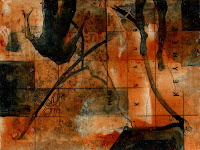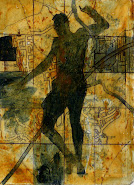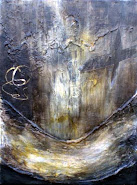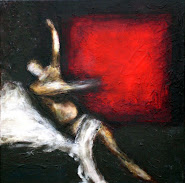Your post the other day really struck me. I think you had some very important points. I don't really want to systemmatically deconstruct it as that will not be an overly constructive process(thats either a pun or lazy english).
What interests me is the need, or lack of need, to justify what we do in words. I think I have, can and will be quilty of over talking my work. It is equally dangerous, as you suggested, to under talk our practise, to totally deny the need for reason or justification. What is important is the nature of what we say. Not so much in terms of quality, but in terms of its ability to feed rather than hinder our work. It should supplement its progression and interpretation, not justify or limit either.
In this forum (if we can call it that) it seems that a lot of talk is not so much about what has been done but what we are in the process of doing. A kinf o forward looking commentary. The danger of this, obviously, is that theory gets ahead of practise. What I hope is that I can find a level where I am finding some kind of linguistic clarity in my thoughts and processes which helps me to find a new visual clairty and direction in my practise. The kind of clairty I am searching for is of a poetic rather than scientific kind. I don't want to justify my every action, to fully understand or explain what I am trying to do. In stead its about finding the arena in which I wish to act out certain little painterly journeys. (if that does not sound too horrifically pretentious)
With that in mind I have had some thoughts over where my current batch of new studies is going...
In most of the new small works I have started imagery seems to be deconstructed rather than constructed. This has something to do with my choice to work from a photographic starting point, with a predefined image laid down on the surface. By its nature I then take this image in a direction (normally with definition and calirty being attacked to various degress). This is oposed to image making, which starts with a material and looks to lay in down in such a way to build up a sense of an image. One is the synthetic construction of images and the other is the analytical deconstruction. With one painterly absrtact parts are used to create, with the other to destroy. The extent to which we go on this journey relates to where we wish to sit in terms of pictorial clarity (clairty here meaning that of a recognisable image) I know that I wish to sit in the ether, somewhere between knowing and not knowing. Snippets of reality lost and found between more painterly tendencies. (trying to write honestly but sounding progressively more pretentious)
This play with image obviously has a role. Painting is more functional and pragmattic than mere random play; however much we sometimes try to tell ourselves it isnt. We always move to the next level of interpretation, which tends to be narrative.
Seeing as I am sometimes taking elements from one narrative and erasing huge parts I am seemingly destroying stories. All the props and actors which interrelate lose meaning if only singular, floating elements are left. But when something is lost something else is found. Perhaps this is what I am after, the forgetting of one story in order to remember another (which does not yet exist in this exact form). This is why I have moved away, in general, form exact subject matter.
What I hope happens is that I find narratives, rather than making images which fulfill preordained stories I had in my head. Obviously I have thoughts in my head. By bringing together falling or flaoting figures, recipts, maps etc I clearly have certain ideas. I wish to keep these vague and think discussing them would perhaps trap their potential to expand and surprise. Issues of journeys, memories, reality and the human condition are obvious loose reference points.
What I hope is that from this mass of 'stuff' stories evolve, that they present themsevles to me. That the painterly process takes over to an extent. I am aware this is a romantic notion, and one I have been trapped in before. Yet I feel, with a more strict framework in place, beyond mere painterly exploration, that the rewards will be worthwhile. What I am enjoying is the process of being in the dark, the adventure of it all. I like the not fully knowing that currently exists.
On a wider level I know the kind of stories I am looking to make. By the nature of the process these will not be clear narratives. The paintings will not be able to read in such a way as to know who is who, who did what to whom, who is where or when or any such other linear or logica sequence of events or relationship of parts. I am more interested in a whole which directs us, its musical...I suppose. I suppose by the unreal nature of such stories I am intersted in allegory over narrative. That is, in something universal not specific. That does not mean I am into philosophy over drama. It just means its a more poetic form of drama. The danger of vague and obtruse philosophical or social dimensions being read into works is not something I am interested in.
Havingt said this I except that as a product of our time our images always offer up some kind of indirect assesment and commentary, however much we seek to avoid it. Even the avoidance of direct association says something in itself. Yet this kind of meaning is the most prone to change and the whims of circumstance and context (historical, physical and social).
Anyway, just some quick thoughts. It might all be bollocks; and probally is, but its kinda of what I am currently thinking...I think.






















































